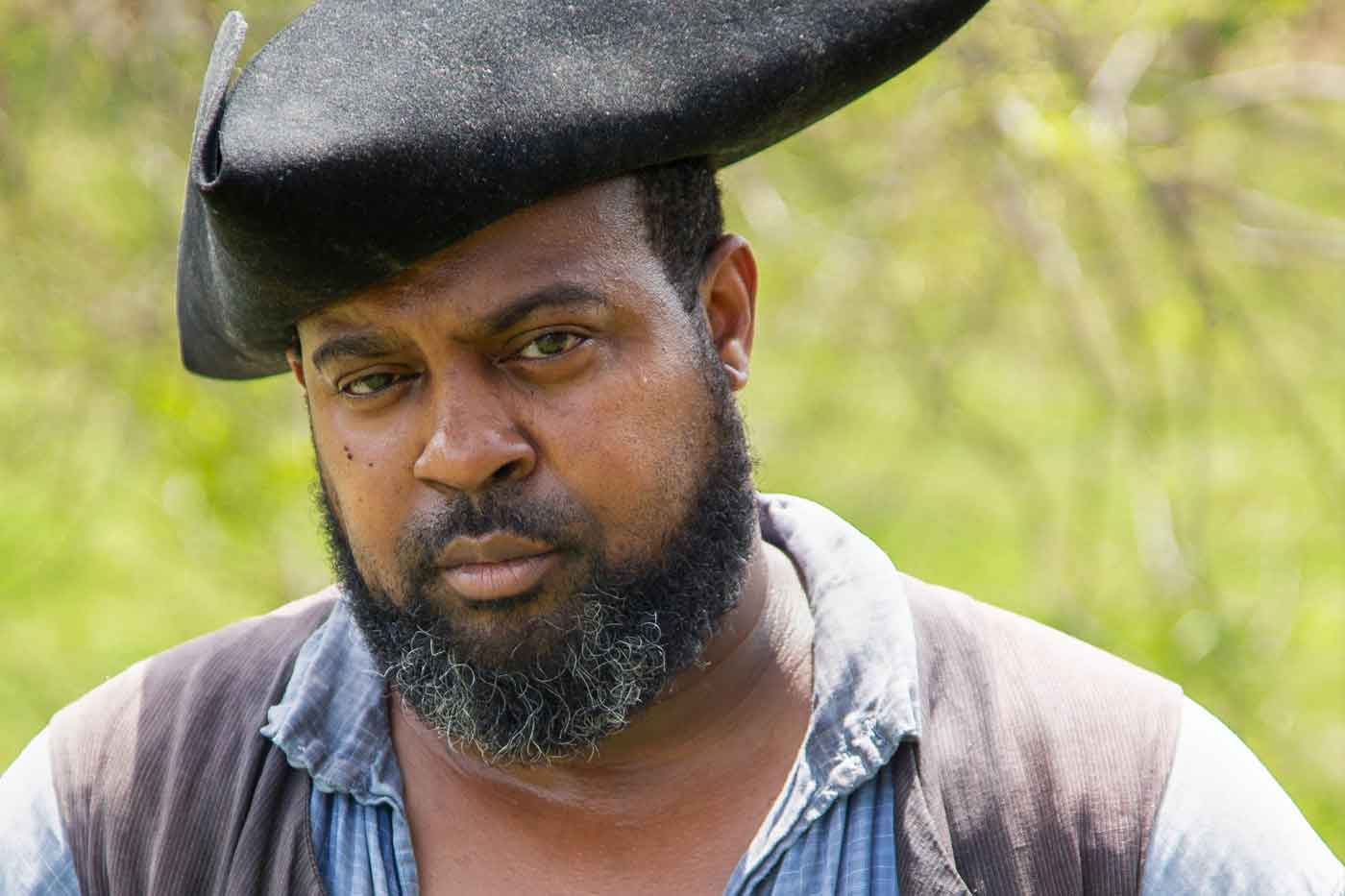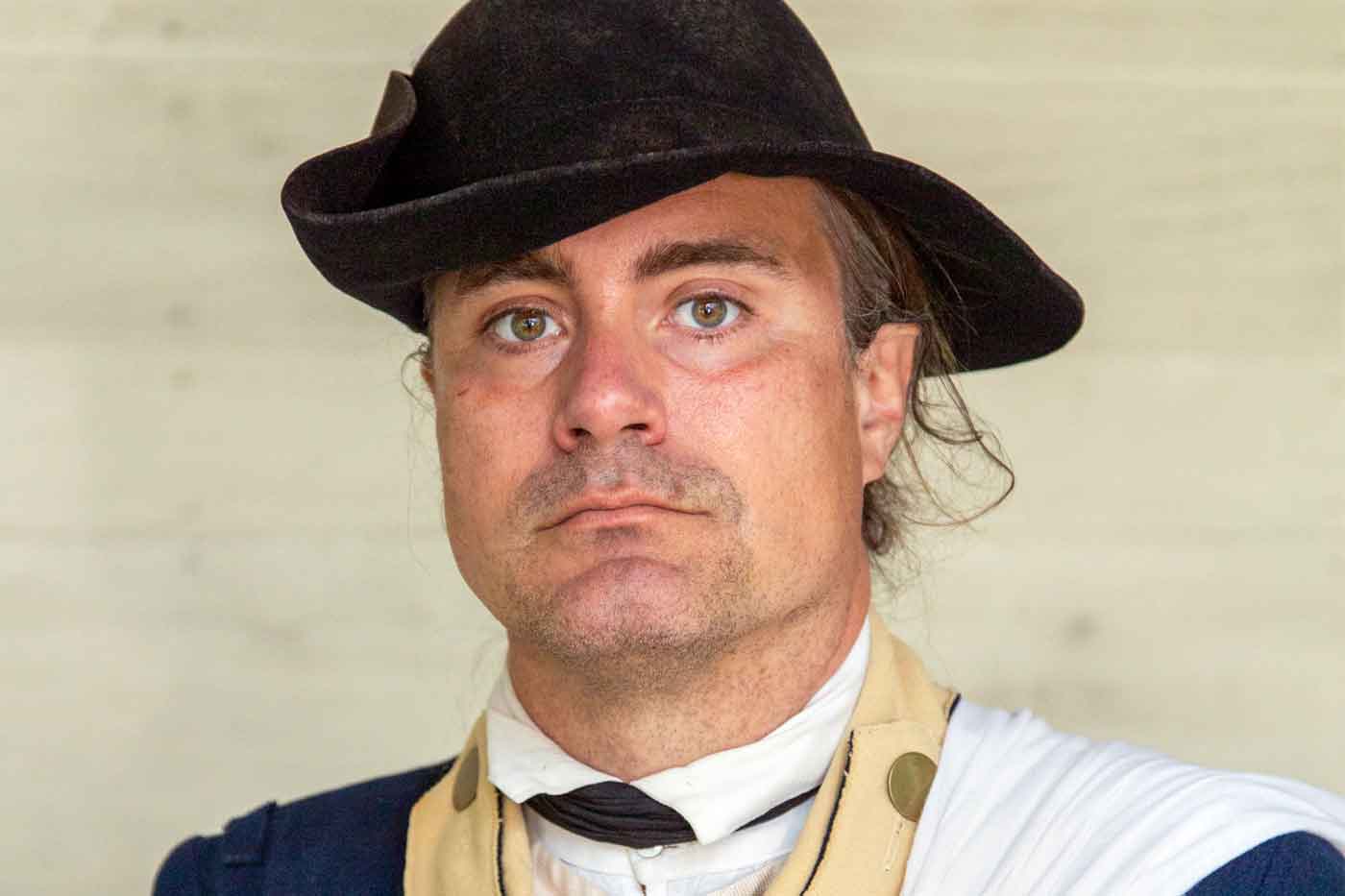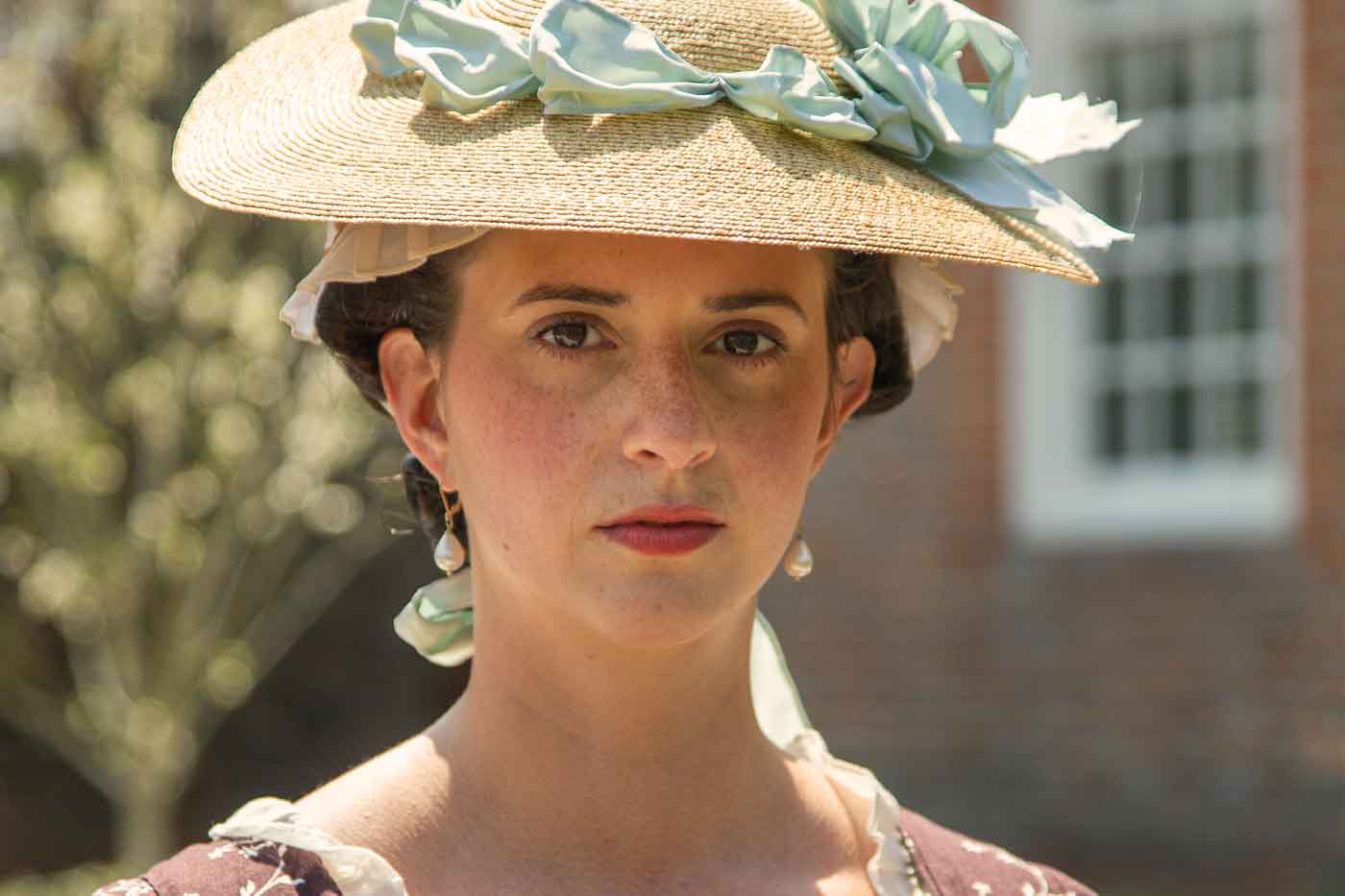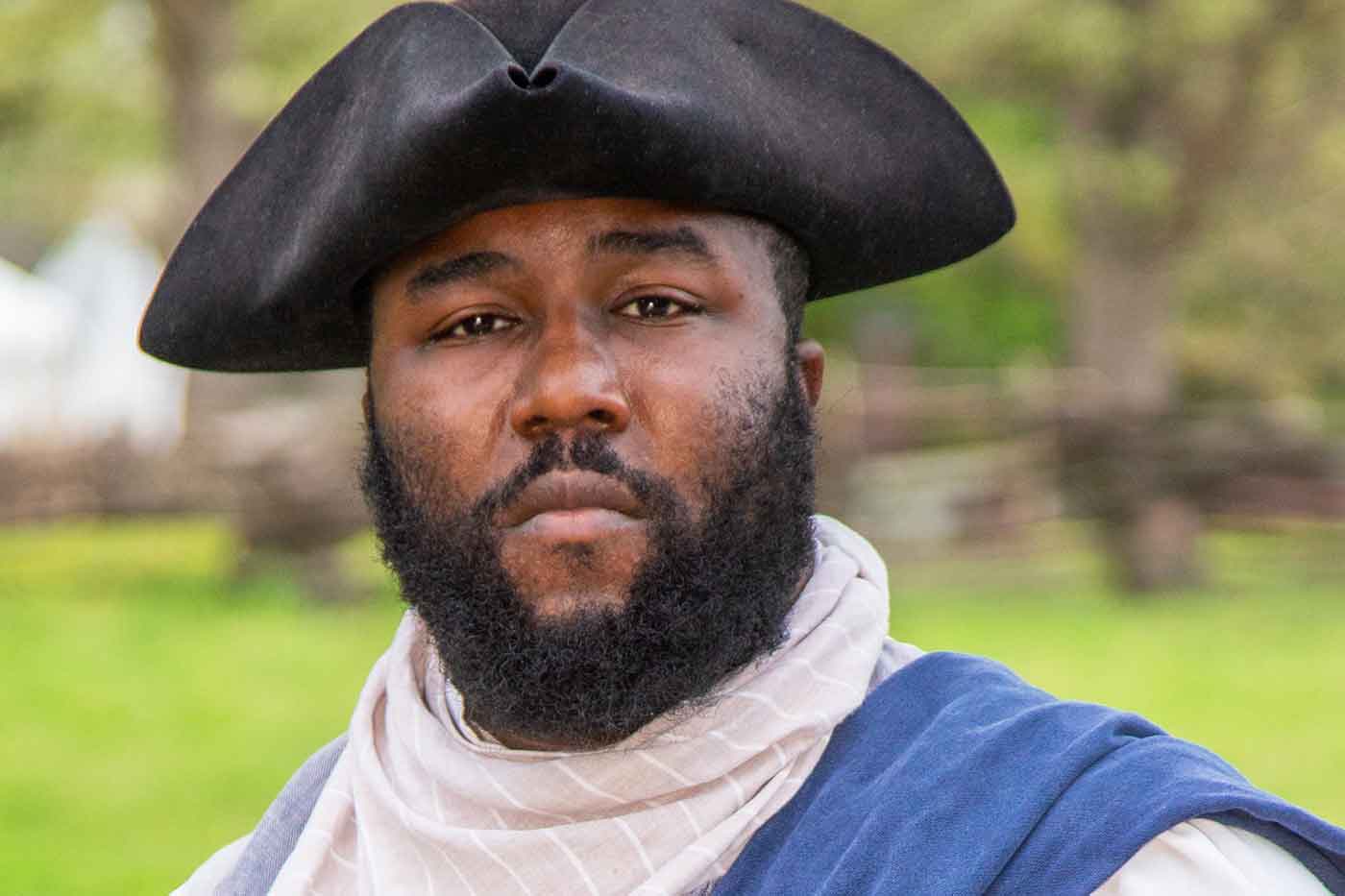Many of the people who lived and worked in 18th-century Williamsburg did not leave an extensive paper trail.
Evidence of a person’s existence might simply be a name on a registry or an unusual military record. But who were they? How did they handle the circumstances of their lives and time?
Actor interpreters sometimes must fill in the blanks, using what is known about the world in which their characters lived to make best guesses on their behaviors, thoughts and beliefs.
My Story, My Voice, a theatrical program launched in 2017, explores the lives of people known to have lived and worked in 18th-century Williamsburg — and about whom we seldom hear. Each performance features one of a rotating slate of actor interpreters portraying a figure in Williamsburg history followed by an out-of-character portion that offers a glimpse into how the character was developed from bits of historical information.
Katrinah Lewis, the artistic director of Museum Theater, and Cheryl Ruschau, the director of Museum Theater, came up with the idea for the program, with Lewis offering the primary creative and development direction.
“My Story, My Voice connects us to the everyday people of the 18th century who lived lives that are as ordinary and extraordinary as our own,” Lewis said. “These are not famous people, but they are a large part of the Williamsburg story.”
Margarette Joyner, Willie Wright, Corinne Dame, Nat Lasley, Michelle Smith and Jeremy Morris share what is known about the individuals they portray in My Story, My Voice and how they developed their interpretations.

Succordia
Portrayed by Margarette Joyner
Succordia is listed in the inventory of Peyton Randolph’s estate as an elder valued at 10 pounds — and that is the extent of what is historically known about her.
Margarette Joyner spotted Succordia’s name as she researched a different woman enslaved by the Randolphs. The voice of the elder had been largely absent from Colonial Williamsburg’s programming, Joyner noticed, and she was determined to one day share that voice through Succordia.
In her extensive research about enslaved Blacks, Joyner had uncovered information about an elderly woman, which provided some context for the story. More inspiration came from Succordia herself.
“I went to the quarters where she would have been, and I just asked her, ‘Succordia, what do you want me to talk about?’” Joyner said. “She answered me with one word: ‘Love.’”
Joyner obliged, pairing Succordia with the only other enslaved person categorized on the inventory as an elder, a man named Braches. Joyner’s performance shows Succordia mourning the death of her husband of 62 years, reflecting on the abundance of love that filled her life despite the conditions under which they lived.
“I think Succordia wanted me to share that they were more than their enslavement,” Joyner said.

Daniel
Portrayed by Willie Wright
Daniel served as the enslaved foreman at Carter’s Grove plantation in the 1760s. He married Judith, an enslaved woman who also lived on the plantation, and the pair had three children — Sam, Phil and Millie.
As foreman, Daniel would have supervised other enslaved people on the plantation. Did that mean he was in a better position to protect them? Or did it mean he helped maintain an inhumane institution?
Willie Wright, who portrays Daniel, knew some of his character’s story because it had been told for more than a decade before Wright took on the role. His piece builds on those former programs, which put Daniel in a situation he possibly could have faced: Cut off the foot of a fellow enslaved man accused of running away or endure the consequences of defying the order.
Daniel successfully pleads for the man, Kofi, to keep his foot, but at a cost. He is ordered to whip Kofi instead, and Daniel’s wife is hired out to another plantation for a year. Historical records show Judith was hired out at least five times while at Carter’s Grove.
“I only ever portray Daniel onstage, never on the streets of the Historic Area, because I have to go to a dark, angry place to be able to do it,” Wright said. “I have to imagine losing my freedom and being put into this community of people who are in the same circumstances as me. I imagine what it’s like to love them and how I want to protect them. And then I have to imagine being part of the machine that’s keeping them down.”

Elizabeth Maloney
Portrayed by Corinne Dame
Elizabeth Maloney had two children with an enslaved man named Moses, out of wedlock, in the mid-1760s. The baptismal records of the children, Jane and Moses, are the only primary sources historians have on Maloney’s life.
The rest of her story, as Corinne Dame portrays her, is educated conjecture. Elizabeth Maloney is presumed to have been white because of her Irish surname, uncommon among enslaved and free Black people in the 18th century. She had a yearslong relationship with a Black man, which would have been illegal, but she seemingly experienced no legal repercussions for it.
Their relationship could have cost Maloney her life with her children. The children could have been bound out as servants until age 31, and Maloney could even have been sentenced to servitude herself. But just because she suffered no legal consequences for her relationship with Moses, who was enslaved by Speaker of the House of Burgesses Peyton Randolph, does not mean she did not suffer societal or emotional costs.
Dame explores these potential costs in her portrayal. During the out-of-character portion of the program, Dame discusses how her own experience with interracial dating, the ultimatums she faced from friends and family, and the sacrifices she did — and didn’t — make all shaped how she wrote the piece.
“I think the societal pressures on Elizabeth and her decision to push against and through them resonates with modern audiences,” said Dame, who has portrayed Maloney for nearly 15 years in various programs. “Family and societal pressures are real. They shape your values, your opinions, your actions, everything. That’s as true today as it was in the 18th century.”

John Jarret Carter
Portrayed by Nat Lasley
John Jarret Carter joined the fight for independence long before the colonies formally declared their separation from Britain. But after suffering a gunshot wound as a soldier in the Continental army and returning home to Williamsburg, the Raleigh Tavern bartender refused to sign the oath of allegiance.
The law required all freeborn men above the age of 16 to subscribe to the oath, and Carter’s refusal is an indication of second thoughts about his early dedication to the American Revolution.
Nat Lasley portrays Carter during this period of disillusionment, exploring why someone who volunteered to risk his life for the American cause would refuse to pledge his allegiance to it. As Carter, Lasley ruminates about the inherent contradictions in the American fight for liberty.
Historians know how the story ends for Carter, but Lasley’s piece is meant to keep the audience guessing about whether Carter rededicates himself to the newly independent America. Out of character, Lasley provides the audience with more historical context to explain Carter’s ultimate decision.
“I see John Jarret Carter as a man with a broken heart, as a man who became obsessed with the idea that the colonies were breaking free from the chains of history to create something new, something better. But he discovered it was messy, especially in those war years, and it left out a lot of people,” Lasley said. “America is easy to love, but it will break your heart from time to time.”

Anne Blair Banister
Portrayed by Michelle Smith
Anne Blair Banister’s family history is well rooted in Williamsburg. The Blairs were a founding family of Virginia: Her great-uncle commissioned the college that ultimately would become William & Mary, and her father served as acting governor.
Because of this deep, well-documented history, including dozens of extant letters from Banister herself, Michelle Smith had much to work with as she wrote her script. Smith sees Banister as a sociable, genuinely fun woman who may have bucked one social norm by marrying at age 32 but adhered to and furthered another — slavery.
Smith focuses on Banister’s relationship with her longtime maidservant, Fanny. The two knew each other from childhood. The program begins with Banister, in her adulthood, questioning Fanny about whether she is harboring her son, Isaac, who is suspected of running away.
The show then rewinds time, showing the two as 10-year-olds, and moves through pivotal moments in Banister’s life to explore her experiences with slavery. In one instance, during her formative years, she saw her slave-owning father help Matthew Ashby, a free Black man, manumit his wife and children. Yet Banister married a man who enslaved hundreds of people.
“Anne chose a life that does not at all question the institution of slavery, despite repeated exposure to an alternative,” Smith said. “What games do you have to play to choose not to see a human in front of you? That’s what I wanted to explore in this piece.”

Sam
Portrayed by Jeremy Morris
Everything historians know about Sam is from one descriptive newspaper ad seeking his return after he escaped.
In the Virginia Gazette ad from June 1775, Sam is described as a man who had purchased his freedom three years before but had been reenslaved based on complaints that “he was attempting to inveigle away a number of negroes to the new or Indian country.”
According to his new owner, the runaway likely would attempt to pass as a freeman because he still had the discharge papers from his old master, as well as Lord Dunmore, for whom he fought in the campaign against the American Indians in the fall of 1774.
Jeremy Morris portrays Sam, who uses his freedom to lead others into the wilderness of American Indian country, where he believes they will be safe and able to live a full life.
Morris came across the runaway ad years ago, often referring to it in other programs as a poignant example of how even when they had a status as “free,” Black people lacked full freedom of movement, of speech, of ideas. Enslavers had the power to tell them how to be free.
“Sam’s story wouldn’t let go of me. I was struck by how complete, how dramatic, how powerful and how frightening this story was, all wrapped up in one runaway ad,” Morris said. “He played by the rules of a rigged game and earned his freedom, but they didn’t like how he used that freedom.”
When Morris speaks to the audience out of character, he wants them to understand how Sam’s story is not so distant from us, that the “ugly, twisted, deep roots of that oppression are still wrapped around us.”
